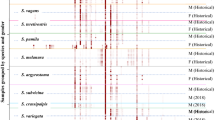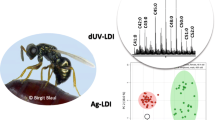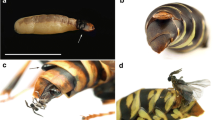Abstract
We extracted the cuticular hydrocarbons from live Dinoponera quadriceps ants (10 colonies collected from Brazil) with the solventless solid-phase microextraction (SPME) technique. Gas chromatography of the SPME samples (N = 233 measurements) compared with pentane extracts (N = 10) resulted in similar profiles. Eighty-one compounds belonging to the main long-chain hydrocarbon families were identified by GC-MS. There is no morphologically specialized queen in D. quadriceps and only one aggressively dominant worker (alpha) mates and reproduces in each colony. The alpha ant (N = 26 individuals) always yielded higher amounts and percentages of 9-hentriacontene (9-C31 : 1) than her sterile nestmates (N = 47). Since SPME is not destructive, it allowed for the repeated extraction of the same individuals, demonstrating that the alpha ant (virgin or mated) always had higher levels of 9-hentriacontene. This difference appears related to ovarian activity and may function as a signal of the alpha's dominance status.
Similar content being viewed by others
REFERENCES
Arnold, G., Quenet, B., Cornuet, J.-M., Masson, C., De Schepper, B., Estoup, A., and Gasqui, P. 1996. Kin recognition in honeybees. Nature 379:498.
Arthur, C. L., and Pawliszyn, J. 1990. Solid phase microextraction with thermal desorption using fused silica optic fibers. Anal. Chem. 62:656.
Arthur, C. L., Potter, D. W., Buchholz, K. D., Motlagh, F., and Pawliszyn, J. 1992. Solid phase microextraction for the direct analysis of water: theory and practice. LC-GC 10:2145.
Ayasse, M., Maelovits, T., TengÖ, J., Taghizadeh, T., and Francke, W. 1995. Are there pheromonal dominance signals in the bumblebee Bombus hypnorum L. (Hymenoptera, Apidae)? Apidologie 26:163–180.
BagnÈres, A.-G., Lorenzi, M. C., Dusticier, G., Turillazi, S., and ClÉment, J.-L. 1996. Chemical usurpation of a nest by paper wasp parasites. Science 272:889–892.
Berlardi, R., and Pawliszyn, J. 1989. The application of chemically modified fused silica fibers in the extraction of organics from water matrix samples and their rapid transfer to capillary columns. Water Pollut. Res. J. Can. 24:179.
Billen, J., BrandÀo, C. R. F., and Paiva, R. V. S. 1995. Morphology and ultrastructure of the pygidial gland of the ant Dinoponera australis (Hymenoptera, Formicidae). Pap. Avulsos Zool. 39:209–216.
Bonavita-Cougourdan, A., ClÉment, J.-L., and Lange, C. 1987. Nestmate recognition: The role of cuticular hydrocarbons in the ant Camponotus vagus Scop. J. Entomol. Sci. 22:1–10.
Bonavita-Cougourdan, A., ThÉraulaz, G., BagnÈres, A.-G., Roux, M., Pratte, M., Provost, E., and ClÉment, J.-L. 1991. Cuticular hydrocarbons, social organization and ovarian development in a polistine wasp: Polistes dominulus Christ. Comp. Biochem. Physiol. 100B:667–680.
Diehl, P. A. 1975. Synthesis and release of hydrocarbons by the oenocytes of the desert locust, Schistocerca gregaria. J. Insect Physiol. 21:1237–1246.
Downing, H. A., and Jeanne, R. L. 1985. Communication of status in the social wasp Polistes fuscatus (Hymenoptera: Vespidae). Z. Tierpsychol. 67:78–96.
Espelie, K. E., Gamboa, G. J., Grudzien, T. A., and Bura, E. A. 1994. Cuticular hydrocarbons of the paper wasp, Polistes fuscatus: A search for recognition pheromones. J. Chem. Ecol. 20:1677–1687.
Ferrer-Correira, A. J., Jennings, K. R., and Sen Sharma, D. K. 1976. The use of ion-molecule reactions in the mass spectrometric location of double bonds. Org. Mass Spectrom. 11:867.
Fletcher, D. J. C., and Ross, K. G. 1985. Regulation of reproduction in eusocial Hymenoptera. Annu. Rev. Entomol. 30:319–343.
FrÉrot, B., Malosse, C., and Cain, A. H. 1997. Solid-phase microextraction (SPME) a new tool in pheromone identification of Lepidoptera. J. High Resolut. Chromatogr. 20:340–342.
Heinze, J., HÖlldobler, B., and Peeters, C. 1994. Conflict and cooperation in ant societies. Naturwissenschaften 81:489–497.
Hepburn, H. R. 1986. Honeybees and Wax—An Experimental Natural History. Springer-Verlag, Berlin.
Ismail, M. T., and Zachary, D. 1984. Sex pheromones in Culicoides nubeculosus (Diptera, Ceratopogonidae): Possible sites of production and emission. J. Chem. Ecol. 10:1385–1398.
Lenoir, A., Malosse, C., and Yamaoka, R. 1997. Chemical mimicry between parasitic ants Formicoxenus and their host Myrmica (Hymenoptera, Formicidae). Biochem. Syst. Ecol. 25:379–389.
Malosse, C., Einhorn, J., and Lenoir, A. 1994. An application of ion-molecule reaction with vinyl methyl ether: direct location of double bond in C25 to C33 monoolefins of ants cuticular extracts. 13th IMSC, Budapest, Hungary, August 29–September 2.
Malosse, C., Ramirez-Lucas, P., Rochat, D., and Morin, J.-P. 1995. Solid-phase microextraction, an alternative method for the study of airborne insect pheromones (Metamasius hemipterus, Coleoptera, Curculionidae). J. High Resolut. Chromatogr. 18:669–670.
Monnin, T., and Peeters, C. 1997. Cannibalism of subordinates' eggs in the monogynous queenless ant Dinoponera quadriceps. Naturwissenschaften 84:499–502.
Monnin, T., and Peeters, C. 1998. Monogyny and regulation of worker mating in the queenless and Dinoponera quadriceps. Anim. Behav. In press.
Mozuraitis, R., Borg-Karlson, A. K., Eiras, A., Witzgall, P., Kovaleski, A., Vilela, E. F., and Unelius, C. R. 1996. Solid Phase Microextraction technique used for collecting volatiles released by individual signalling Bonagota cranaodes moths. 13th ISCE, Prague, Czech Republic, August 18–22.
Noirot, C., and Quennedey, A. 1991. Glands, gland cells, glandular units: Some comments on terminology and classification. Ann. Soc. Entomol. Fr. 27:123–128.
Oldham, N. J., Keegans, S. J., Morgan, E. D., Paiva, R. V. S., BrandÃo, C. R. F., Schoeters, E., and Billen, J. P. J. 1994. Mandibular gland contents of a colony of the queenless ponerine ant Dinoponera australis. Naturwissenschaften 81:313–316.
Paiva, R. V. S., and BrandÃo, C. R. F. 1995. Nests, worker population, and reproductive status of workers, in the true giant queenless ponerine ant Dinoponera Roger (Hymenoptera: Formicidae). Ethol. Ecol. Evol. 7:297–312.
Peeters, C. 1993. Monogyny and polygyny in ponerine ants with or without queens, pp. 235–261, in L. Keller (ed.). Queen Number and Sociality in Insects. Oxford University Press, New York.
Plettner, E., Slessor, K. N., Winston, M. L., and Oliver, J. E. 1996. Caste-selective pheromone biosynthesis in honeybees. Science 271:1851–1853.
Reeve, H. K. 1991. Polistes, pp. 99–148, in K. G. Ross and R. W. Matthews (eds.). The Social Biology of Wasps. Cornell University Press, Ithaca.
Reyment, R. A. 1989. Compositional data analysis. Terra Rev. 1:29–34.
RÖseler, P.-F. 1991a. Reproductive competition during colony establishment, pp. 309–335, in K. G. Ross and R. W. Matthews, (eds.). The Social Biology of Wasps. Cornell University Press, Ithaca.
RÖseler, P.-F. 1991b. Roles of morphogenetic hormones in caste polymorphism in bumble bees. pp. 384–399, in A. P. Gupta (ed.). Morphogenetic Hormones of Arthropods: Roles in Histogenesis, Organogenesis, and Morphogenesis. Rutgers University Press, New Brunswick, New Jersey.
Trabalon, M., Campan, M., Porcheron, P., ClÉment, J.-L., Baehr, J.-C., MoriniÈre, M., and Joulie, C. 1990. Relationships among hormonal changes, cuticular hydrocarbons, and attractiveness during the first gonadotropic cycle of the female Calliphora vomitoria (Diptera). Gen. Comp. Endocrinol. 80:216–222.
Visscher, P. K., and Dukas, R. 1995. Honeybees recognize development of nestmates' ovaries. Anim. Behav. 49:542–544.
West-Eberhard, M. J. 1977. The establishment of reproductive dominance in social wasp colonies, pp. 223–227, in Proceedings, 8th International Congress, IUSSI, Wageningen.
Winston, M. L. 1987. The Biology of the Honey Bee. Harvard University Press, London, 281 pp.
Author information
Authors and Affiliations
Rights and permissions
About this article
Cite this article
Monnin, T., Malosse, C. & Peeters, C. Solid-Phase Microextraction and Cuticular Hydrocarbon Differences Related to Reproductive Activity in Queenless Ant Dinoponera quadriceps . J Chem Ecol 24, 473–490 (1998). https://doi.org/10.1023/A:1022360718870
Issue Date:
DOI: https://doi.org/10.1023/A:1022360718870




